Project Management Report: Redeveloping an App for Uber Drivers
VerifiedAdded on 2023/01/17
|8
|2173
|36
Report
AI Summary
This report delves into the application of project management principles in the context of redeveloping an app for Uber drivers. It begins by examining the impact of PM practices and the PMI's code of ethics, highlighting the relevance of PMBOK knowledge areas and ethical considerations in defining project scope, objectives, and stakeholder roles. The report then compares and contrasts different project management approaches, including phased, lean, and iterative methodologies, concluding that an iterative or incremental approach is most suitable for the project due to its flexibility in adapting to changing requirements and managing risks. Furthermore, the report explores various project management techniques and tools for risk management, such as documentation review, brainstorming, and root cause analysis, emphasizing their importance in identifying and mitigating potential risks associated with the project. The paper concludes by summarizing the key findings and emphasizing the importance of these practices, approaches and tools for successful project execution.
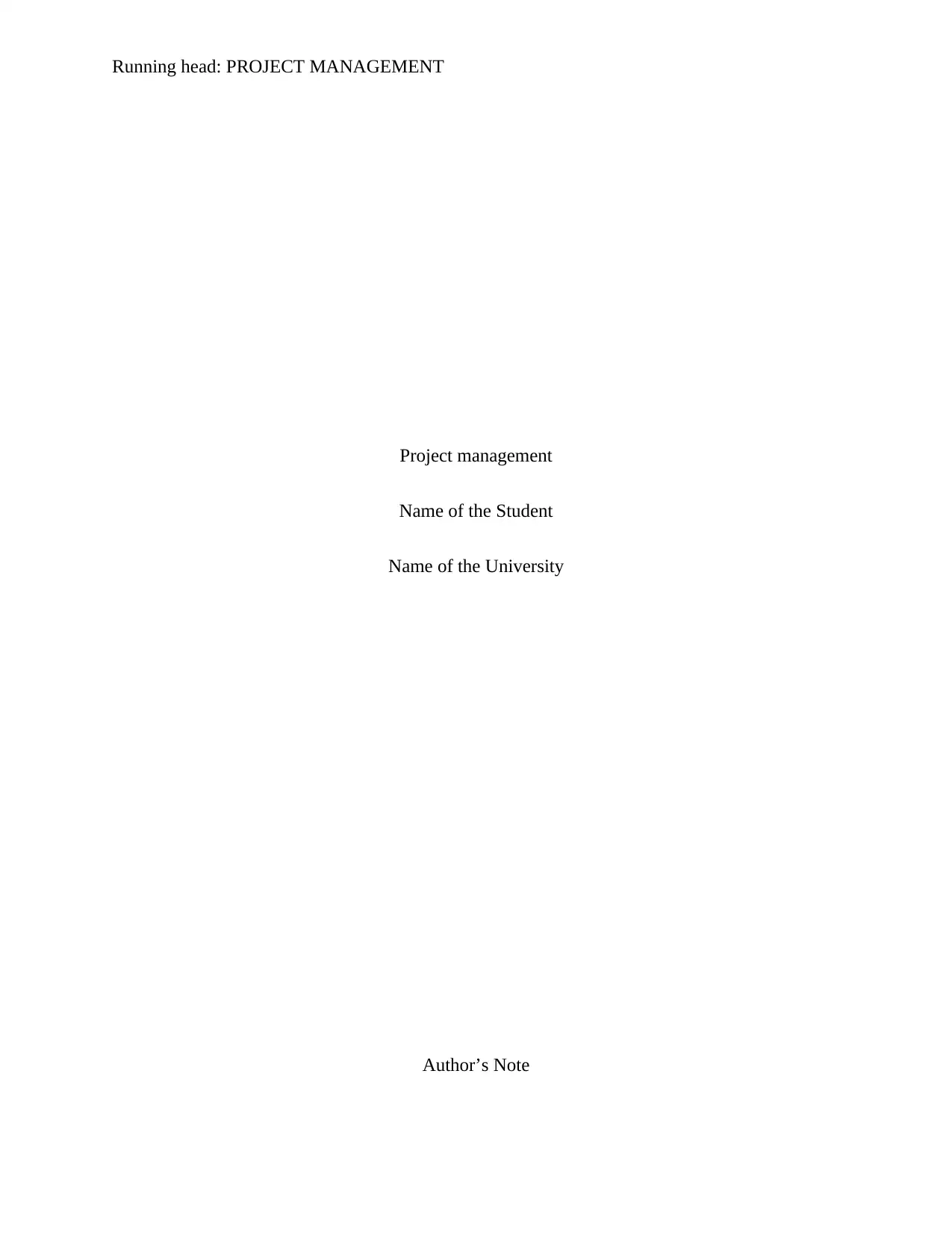
Running head: PROJECT MANAGEMENT
Project management
Name of the Student
Name of the University
Author’s Note
Project management
Name of the Student
Name of the University
Author’s Note
Paraphrase This Document
Need a fresh take? Get an instant paraphrase of this document with our AI Paraphraser
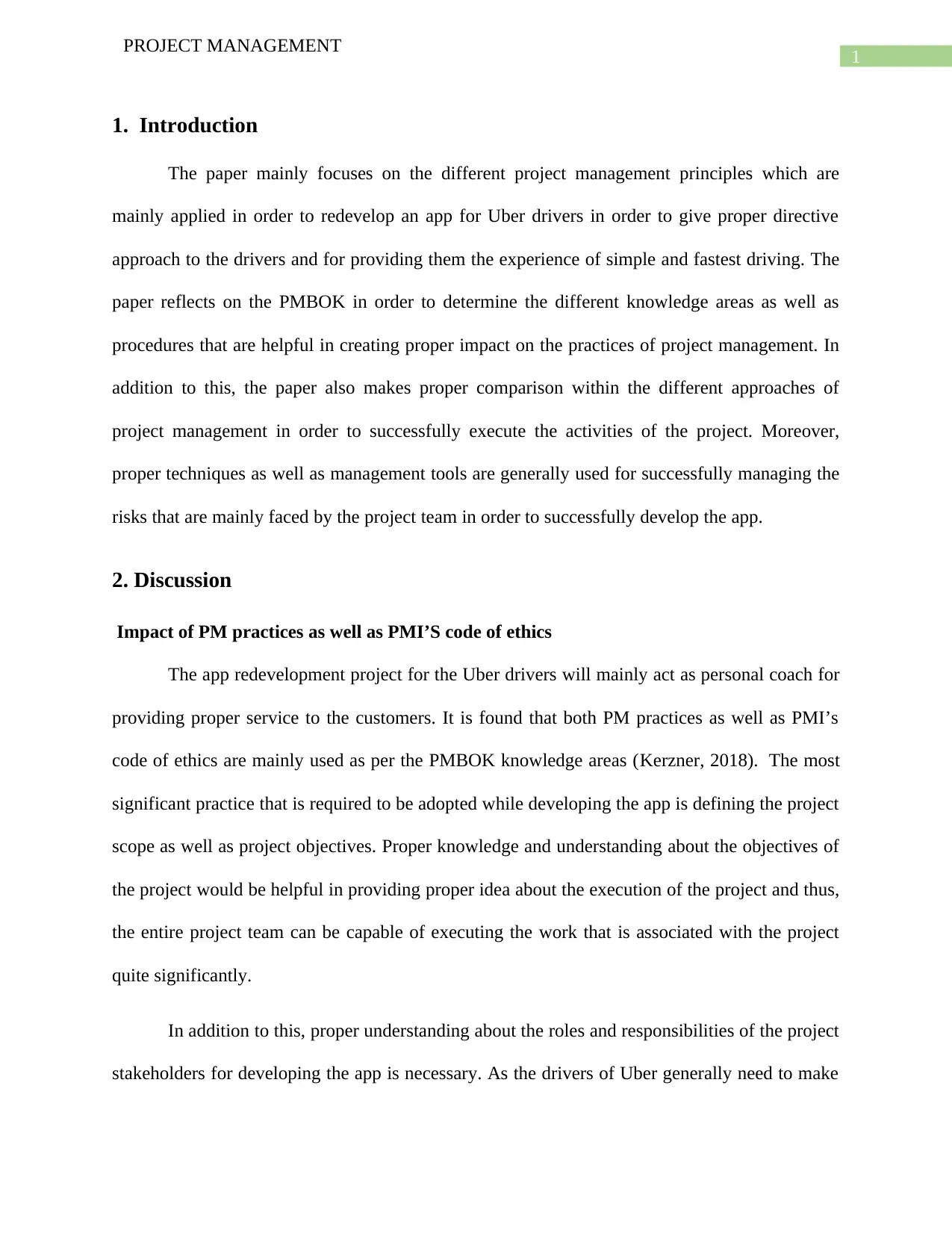
1
PROJECT MANAGEMENT
1. Introduction
The paper mainly focuses on the different project management principles which are
mainly applied in order to redevelop an app for Uber drivers in order to give proper directive
approach to the drivers and for providing them the experience of simple and fastest driving. The
paper reflects on the PMBOK in order to determine the different knowledge areas as well as
procedures that are helpful in creating proper impact on the practices of project management. In
addition to this, the paper also makes proper comparison within the different approaches of
project management in order to successfully execute the activities of the project. Moreover,
proper techniques as well as management tools are generally used for successfully managing the
risks that are mainly faced by the project team in order to successfully develop the app.
2. Discussion
Impact of PM practices as well as PMI’S code of ethics
The app redevelopment project for the Uber drivers will mainly act as personal coach for
providing proper service to the customers. It is found that both PM practices as well as PMI’s
code of ethics are mainly used as per the PMBOK knowledge areas (Kerzner, 2018). The most
significant practice that is required to be adopted while developing the app is defining the project
scope as well as project objectives. Proper knowledge and understanding about the objectives of
the project would be helpful in providing proper idea about the execution of the project and thus,
the entire project team can be capable of executing the work that is associated with the project
quite significantly.
In addition to this, proper understanding about the roles and responsibilities of the project
stakeholders for developing the app is necessary. As the drivers of Uber generally need to make
PROJECT MANAGEMENT
1. Introduction
The paper mainly focuses on the different project management principles which are
mainly applied in order to redevelop an app for Uber drivers in order to give proper directive
approach to the drivers and for providing them the experience of simple and fastest driving. The
paper reflects on the PMBOK in order to determine the different knowledge areas as well as
procedures that are helpful in creating proper impact on the practices of project management. In
addition to this, the paper also makes proper comparison within the different approaches of
project management in order to successfully execute the activities of the project. Moreover,
proper techniques as well as management tools are generally used for successfully managing the
risks that are mainly faced by the project team in order to successfully develop the app.
2. Discussion
Impact of PM practices as well as PMI’S code of ethics
The app redevelopment project for the Uber drivers will mainly act as personal coach for
providing proper service to the customers. It is found that both PM practices as well as PMI’s
code of ethics are mainly used as per the PMBOK knowledge areas (Kerzner, 2018). The most
significant practice that is required to be adopted while developing the app is defining the project
scope as well as project objectives. Proper knowledge and understanding about the objectives of
the project would be helpful in providing proper idea about the execution of the project and thus,
the entire project team can be capable of executing the work that is associated with the project
quite significantly.
In addition to this, proper understanding about the roles and responsibilities of the project
stakeholders for developing the app is necessary. As the drivers of Uber generally need to make
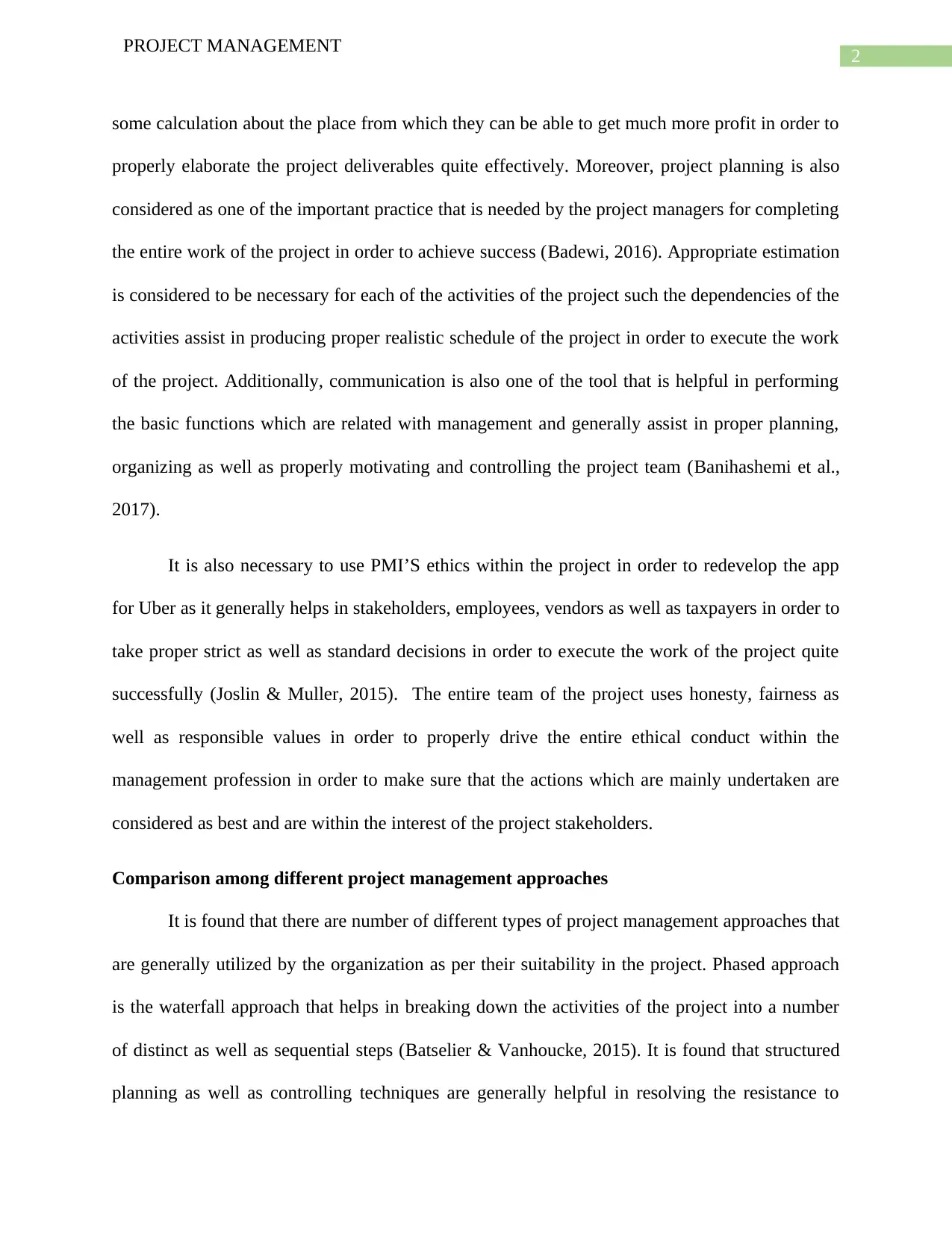
2
PROJECT MANAGEMENT
some calculation about the place from which they can be able to get much more profit in order to
properly elaborate the project deliverables quite effectively. Moreover, project planning is also
considered as one of the important practice that is needed by the project managers for completing
the entire work of the project in order to achieve success (Badewi, 2016). Appropriate estimation
is considered to be necessary for each of the activities of the project such the dependencies of the
activities assist in producing proper realistic schedule of the project in order to execute the work
of the project. Additionally, communication is also one of the tool that is helpful in performing
the basic functions which are related with management and generally assist in proper planning,
organizing as well as properly motivating and controlling the project team (Banihashemi et al.,
2017).
It is also necessary to use PMI’S ethics within the project in order to redevelop the app
for Uber as it generally helps in stakeholders, employees, vendors as well as taxpayers in order to
take proper strict as well as standard decisions in order to execute the work of the project quite
successfully (Joslin & Muller, 2015). The entire team of the project uses honesty, fairness as
well as responsible values in order to properly drive the entire ethical conduct within the
management profession in order to make sure that the actions which are mainly undertaken are
considered as best and are within the interest of the project stakeholders.
Comparison among different project management approaches
It is found that there are number of different types of project management approaches that
are generally utilized by the organization as per their suitability in the project. Phased approach
is the waterfall approach that helps in breaking down the activities of the project into a number
of distinct as well as sequential steps (Batselier & Vanhoucke, 2015). It is found that structured
planning as well as controlling techniques are generally helpful in resolving the resistance to
PROJECT MANAGEMENT
some calculation about the place from which they can be able to get much more profit in order to
properly elaborate the project deliverables quite effectively. Moreover, project planning is also
considered as one of the important practice that is needed by the project managers for completing
the entire work of the project in order to achieve success (Badewi, 2016). Appropriate estimation
is considered to be necessary for each of the activities of the project such the dependencies of the
activities assist in producing proper realistic schedule of the project in order to execute the work
of the project. Additionally, communication is also one of the tool that is helpful in performing
the basic functions which are related with management and generally assist in proper planning,
organizing as well as properly motivating and controlling the project team (Banihashemi et al.,
2017).
It is also necessary to use PMI’S ethics within the project in order to redevelop the app
for Uber as it generally helps in stakeholders, employees, vendors as well as taxpayers in order to
take proper strict as well as standard decisions in order to execute the work of the project quite
successfully (Joslin & Muller, 2015). The entire team of the project uses honesty, fairness as
well as responsible values in order to properly drive the entire ethical conduct within the
management profession in order to make sure that the actions which are mainly undertaken are
considered as best and are within the interest of the project stakeholders.
Comparison among different project management approaches
It is found that there are number of different types of project management approaches that
are generally utilized by the organization as per their suitability in the project. Phased approach
is the waterfall approach that helps in breaking down the activities of the project into a number
of distinct as well as sequential steps (Batselier & Vanhoucke, 2015). It is found that structured
planning as well as controlling techniques are generally helpful in resolving the resistance to
⊘ This is a preview!⊘
Do you want full access?
Subscribe today to unlock all pages.

Trusted by 1+ million students worldwide
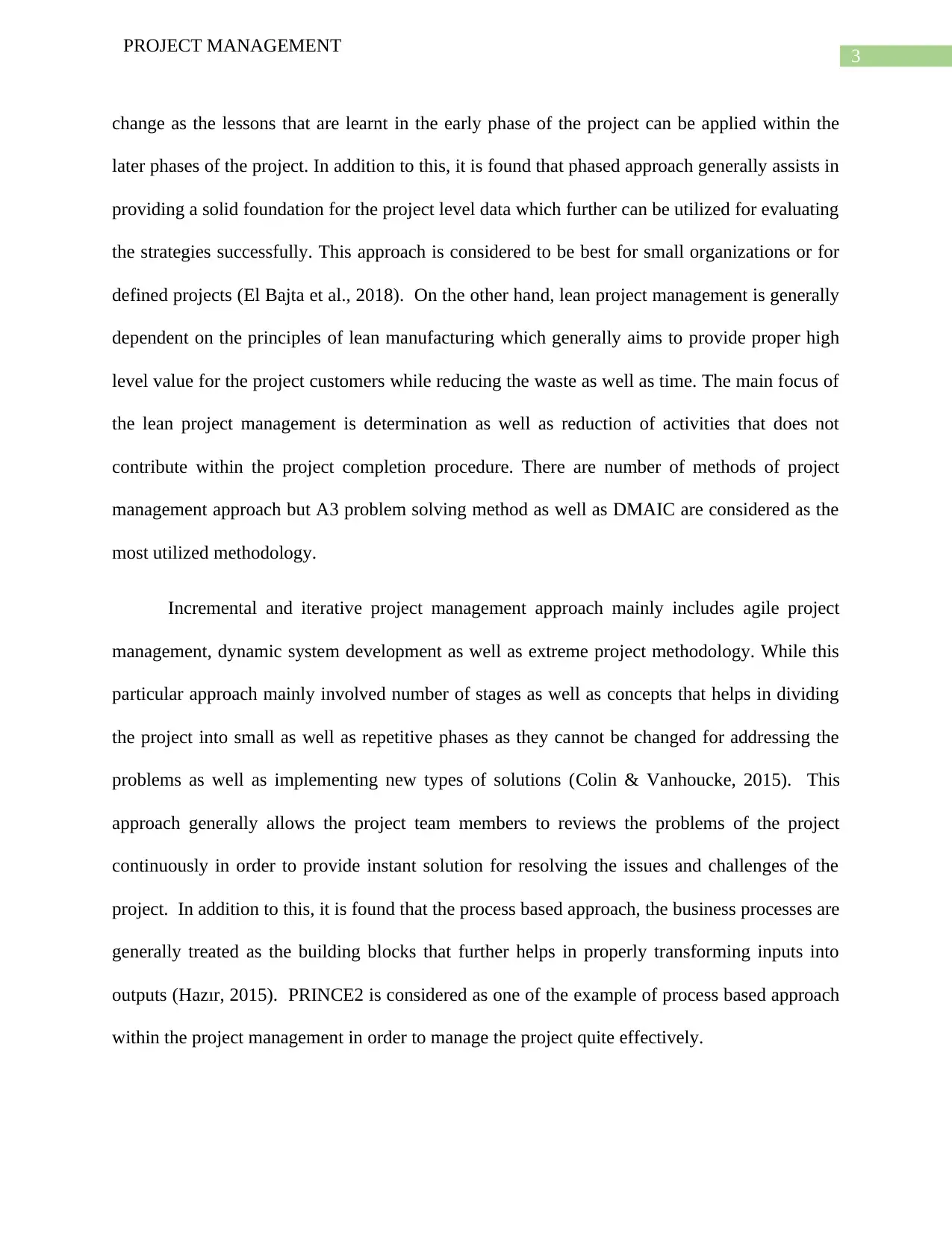
3
PROJECT MANAGEMENT
change as the lessons that are learnt in the early phase of the project can be applied within the
later phases of the project. In addition to this, it is found that phased approach generally assists in
providing a solid foundation for the project level data which further can be utilized for evaluating
the strategies successfully. This approach is considered to be best for small organizations or for
defined projects (El Bajta et al., 2018). On the other hand, lean project management is generally
dependent on the principles of lean manufacturing which generally aims to provide proper high
level value for the project customers while reducing the waste as well as time. The main focus of
the lean project management is determination as well as reduction of activities that does not
contribute within the project completion procedure. There are number of methods of project
management approach but A3 problem solving method as well as DMAIC are considered as the
most utilized methodology.
Incremental and iterative project management approach mainly includes agile project
management, dynamic system development as well as extreme project methodology. While this
particular approach mainly involved number of stages as well as concepts that helps in dividing
the project into small as well as repetitive phases as they cannot be changed for addressing the
problems as well as implementing new types of solutions (Colin & Vanhoucke, 2015). This
approach generally allows the project team members to reviews the problems of the project
continuously in order to provide instant solution for resolving the issues and challenges of the
project. In addition to this, it is found that the process based approach, the business processes are
generally treated as the building blocks that further helps in properly transforming inputs into
outputs (Hazır, 2015). PRINCE2 is considered as one of the example of process based approach
within the project management in order to manage the project quite effectively.
PROJECT MANAGEMENT
change as the lessons that are learnt in the early phase of the project can be applied within the
later phases of the project. In addition to this, it is found that phased approach generally assists in
providing a solid foundation for the project level data which further can be utilized for evaluating
the strategies successfully. This approach is considered to be best for small organizations or for
defined projects (El Bajta et al., 2018). On the other hand, lean project management is generally
dependent on the principles of lean manufacturing which generally aims to provide proper high
level value for the project customers while reducing the waste as well as time. The main focus of
the lean project management is determination as well as reduction of activities that does not
contribute within the project completion procedure. There are number of methods of project
management approach but A3 problem solving method as well as DMAIC are considered as the
most utilized methodology.
Incremental and iterative project management approach mainly includes agile project
management, dynamic system development as well as extreme project methodology. While this
particular approach mainly involved number of stages as well as concepts that helps in dividing
the project into small as well as repetitive phases as they cannot be changed for addressing the
problems as well as implementing new types of solutions (Colin & Vanhoucke, 2015). This
approach generally allows the project team members to reviews the problems of the project
continuously in order to provide instant solution for resolving the issues and challenges of the
project. In addition to this, it is found that the process based approach, the business processes are
generally treated as the building blocks that further helps in properly transforming inputs into
outputs (Hazır, 2015). PRINCE2 is considered as one of the example of process based approach
within the project management in order to manage the project quite effectively.
Paraphrase This Document
Need a fresh take? Get an instant paraphrase of this document with our AI Paraphraser
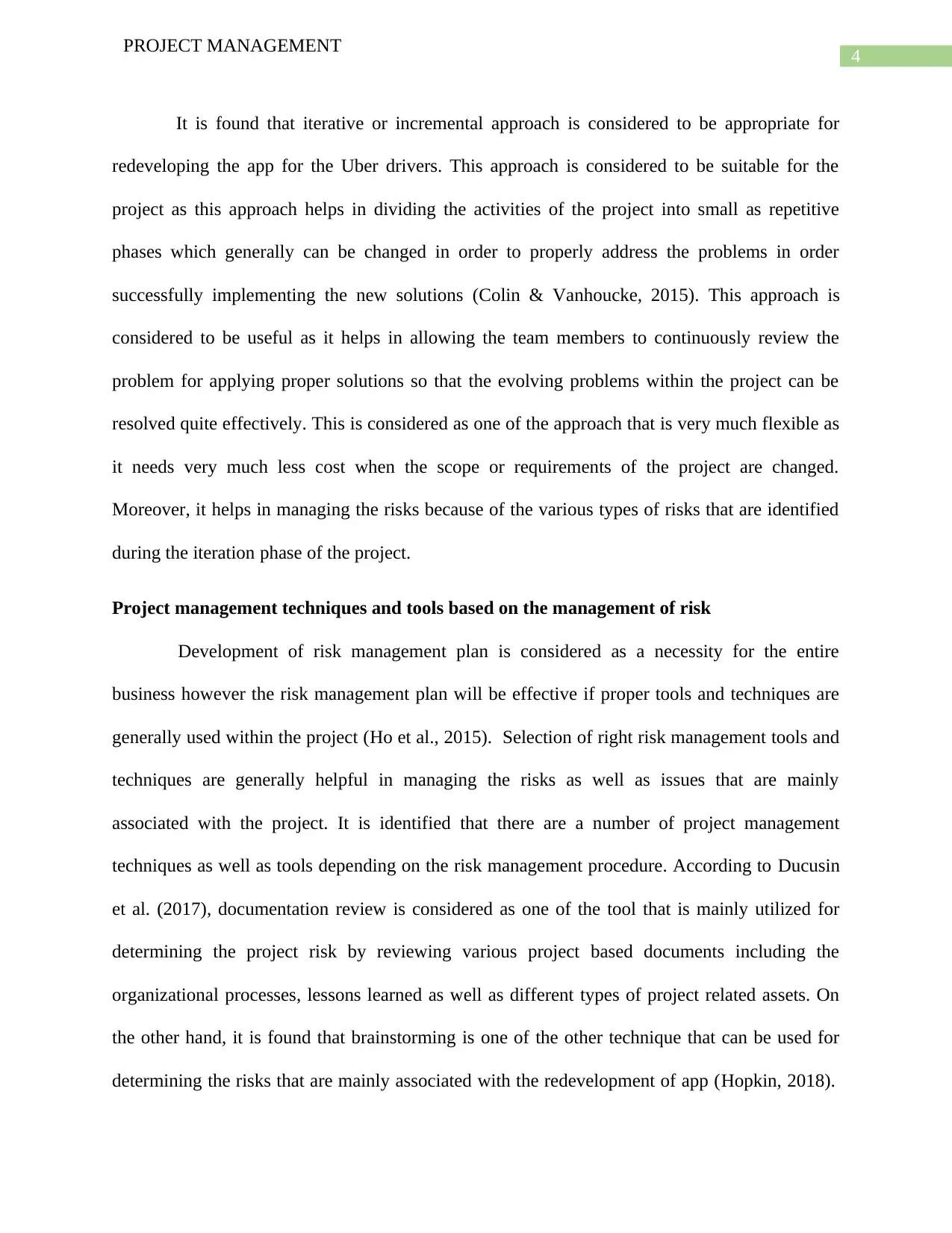
4
PROJECT MANAGEMENT
It is found that iterative or incremental approach is considered to be appropriate for
redeveloping the app for the Uber drivers. This approach is considered to be suitable for the
project as this approach helps in dividing the activities of the project into small as repetitive
phases which generally can be changed in order to properly address the problems in order
successfully implementing the new solutions (Colin & Vanhoucke, 2015). This approach is
considered to be useful as it helps in allowing the team members to continuously review the
problem for applying proper solutions so that the evolving problems within the project can be
resolved quite effectively. This is considered as one of the approach that is very much flexible as
it needs very much less cost when the scope or requirements of the project are changed.
Moreover, it helps in managing the risks because of the various types of risks that are identified
during the iteration phase of the project.
Project management techniques and tools based on the management of risk
Development of risk management plan is considered as a necessity for the entire
business however the risk management plan will be effective if proper tools and techniques are
generally used within the project (Ho et al., 2015). Selection of right risk management tools and
techniques are generally helpful in managing the risks as well as issues that are mainly
associated with the project. It is identified that there are a number of project management
techniques as well as tools depending on the risk management procedure. According to Ducusin
et al. (2017), documentation review is considered as one of the tool that is mainly utilized for
determining the project risk by reviewing various project based documents including the
organizational processes, lessons learned as well as different types of project related assets. On
the other hand, it is found that brainstorming is one of the other technique that can be used for
determining the risks that are mainly associated with the redevelopment of app (Hopkin, 2018).
PROJECT MANAGEMENT
It is found that iterative or incremental approach is considered to be appropriate for
redeveloping the app for the Uber drivers. This approach is considered to be suitable for the
project as this approach helps in dividing the activities of the project into small as repetitive
phases which generally can be changed in order to properly address the problems in order
successfully implementing the new solutions (Colin & Vanhoucke, 2015). This approach is
considered to be useful as it helps in allowing the team members to continuously review the
problem for applying proper solutions so that the evolving problems within the project can be
resolved quite effectively. This is considered as one of the approach that is very much flexible as
it needs very much less cost when the scope or requirements of the project are changed.
Moreover, it helps in managing the risks because of the various types of risks that are identified
during the iteration phase of the project.
Project management techniques and tools based on the management of risk
Development of risk management plan is considered as a necessity for the entire
business however the risk management plan will be effective if proper tools and techniques are
generally used within the project (Ho et al., 2015). Selection of right risk management tools and
techniques are generally helpful in managing the risks as well as issues that are mainly
associated with the project. It is identified that there are a number of project management
techniques as well as tools depending on the risk management procedure. According to Ducusin
et al. (2017), documentation review is considered as one of the tool that is mainly utilized for
determining the project risk by reviewing various project based documents including the
organizational processes, lessons learned as well as different types of project related assets. On
the other hand, it is found that brainstorming is one of the other technique that can be used for
determining the risks that are mainly associated with the redevelopment of app (Hopkin, 2018).
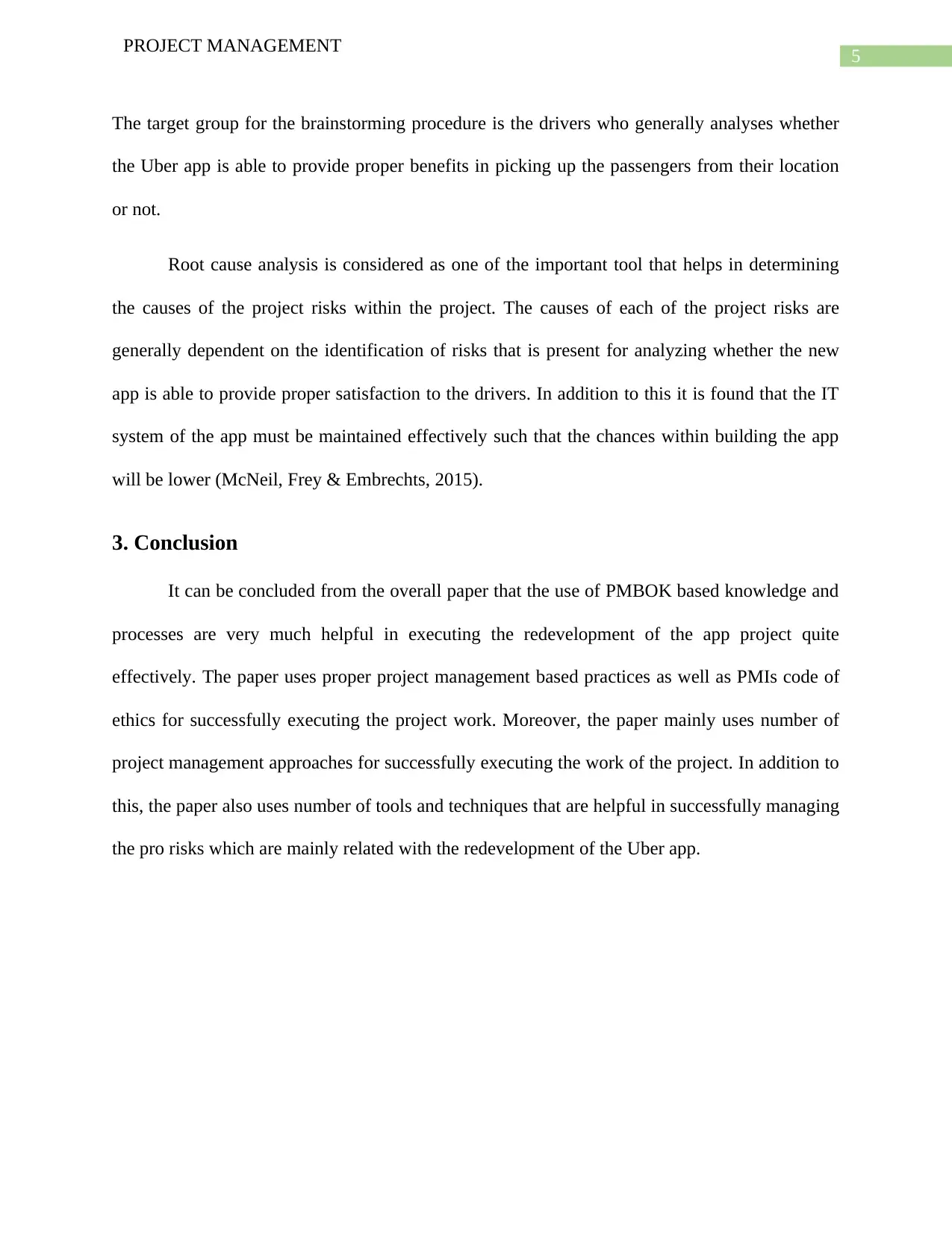
5
PROJECT MANAGEMENT
The target group for the brainstorming procedure is the drivers who generally analyses whether
the Uber app is able to provide proper benefits in picking up the passengers from their location
or not.
Root cause analysis is considered as one of the important tool that helps in determining
the causes of the project risks within the project. The causes of each of the project risks are
generally dependent on the identification of risks that is present for analyzing whether the new
app is able to provide proper satisfaction to the drivers. In addition to this it is found that the IT
system of the app must be maintained effectively such that the chances within building the app
will be lower (McNeil, Frey & Embrechts, 2015).
3. Conclusion
It can be concluded from the overall paper that the use of PMBOK based knowledge and
processes are very much helpful in executing the redevelopment of the app project quite
effectively. The paper uses proper project management based practices as well as PMIs code of
ethics for successfully executing the project work. Moreover, the paper mainly uses number of
project management approaches for successfully executing the work of the project. In addition to
this, the paper also uses number of tools and techniques that are helpful in successfully managing
the pro risks which are mainly related with the redevelopment of the Uber app.
PROJECT MANAGEMENT
The target group for the brainstorming procedure is the drivers who generally analyses whether
the Uber app is able to provide proper benefits in picking up the passengers from their location
or not.
Root cause analysis is considered as one of the important tool that helps in determining
the causes of the project risks within the project. The causes of each of the project risks are
generally dependent on the identification of risks that is present for analyzing whether the new
app is able to provide proper satisfaction to the drivers. In addition to this it is found that the IT
system of the app must be maintained effectively such that the chances within building the app
will be lower (McNeil, Frey & Embrechts, 2015).
3. Conclusion
It can be concluded from the overall paper that the use of PMBOK based knowledge and
processes are very much helpful in executing the redevelopment of the app project quite
effectively. The paper uses proper project management based practices as well as PMIs code of
ethics for successfully executing the project work. Moreover, the paper mainly uses number of
project management approaches for successfully executing the work of the project. In addition to
this, the paper also uses number of tools and techniques that are helpful in successfully managing
the pro risks which are mainly related with the redevelopment of the Uber app.
⊘ This is a preview!⊘
Do you want full access?
Subscribe today to unlock all pages.

Trusted by 1+ million students worldwide
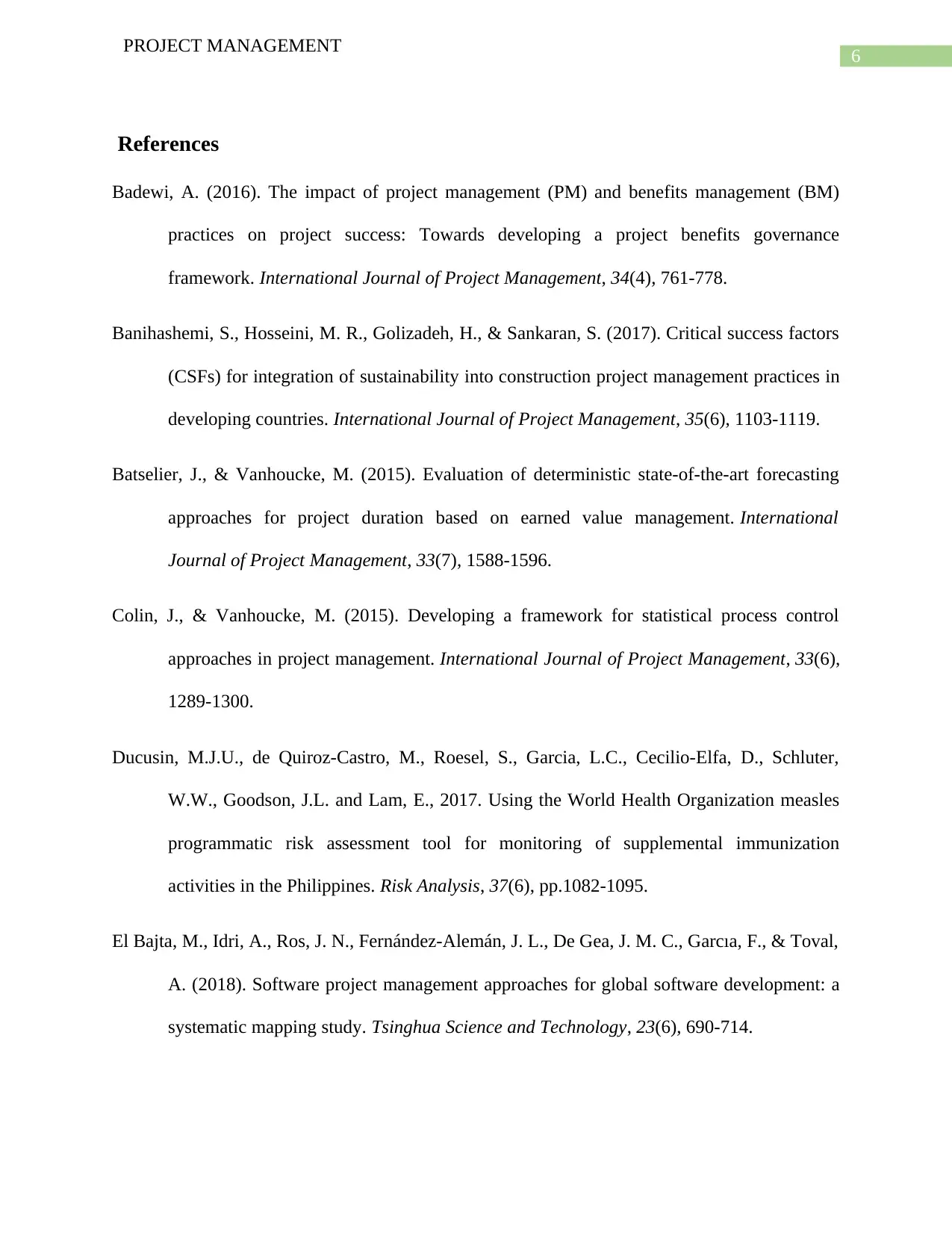
6
PROJECT MANAGEMENT
References
Badewi, A. (2016). The impact of project management (PM) and benefits management (BM)
practices on project success: Towards developing a project benefits governance
framework. International Journal of Project Management, 34(4), 761-778.
Banihashemi, S., Hosseini, M. R., Golizadeh, H., & Sankaran, S. (2017). Critical success factors
(CSFs) for integration of sustainability into construction project management practices in
developing countries. International Journal of Project Management, 35(6), 1103-1119.
Batselier, J., & Vanhoucke, M. (2015). Evaluation of deterministic state-of-the-art forecasting
approaches for project duration based on earned value management. International
Journal of Project Management, 33(7), 1588-1596.
Colin, J., & Vanhoucke, M. (2015). Developing a framework for statistical process control
approaches in project management. International Journal of Project Management, 33(6),
1289-1300.
Ducusin, M.J.U., de Quiroz‐Castro, M., Roesel, S., Garcia, L.C., Cecilio‐Elfa, D., Schluter,
W.W., Goodson, J.L. and Lam, E., 2017. Using the World Health Organization measles
programmatic risk assessment tool for monitoring of supplemental immunization
activities in the Philippines. Risk Analysis, 37(6), pp.1082-1095.
El Bajta, M., Idri, A., Ros, J. N., Fernández-Alemán, J. L., De Gea, J. M. C., Garcıa, F., & Toval,
A. (2018). Software project management approaches for global software development: a
systematic mapping study. Tsinghua Science and Technology, 23(6), 690-714.
PROJECT MANAGEMENT
References
Badewi, A. (2016). The impact of project management (PM) and benefits management (BM)
practices on project success: Towards developing a project benefits governance
framework. International Journal of Project Management, 34(4), 761-778.
Banihashemi, S., Hosseini, M. R., Golizadeh, H., & Sankaran, S. (2017). Critical success factors
(CSFs) for integration of sustainability into construction project management practices in
developing countries. International Journal of Project Management, 35(6), 1103-1119.
Batselier, J., & Vanhoucke, M. (2015). Evaluation of deterministic state-of-the-art forecasting
approaches for project duration based on earned value management. International
Journal of Project Management, 33(7), 1588-1596.
Colin, J., & Vanhoucke, M. (2015). Developing a framework for statistical process control
approaches in project management. International Journal of Project Management, 33(6),
1289-1300.
Ducusin, M.J.U., de Quiroz‐Castro, M., Roesel, S., Garcia, L.C., Cecilio‐Elfa, D., Schluter,
W.W., Goodson, J.L. and Lam, E., 2017. Using the World Health Organization measles
programmatic risk assessment tool for monitoring of supplemental immunization
activities in the Philippines. Risk Analysis, 37(6), pp.1082-1095.
El Bajta, M., Idri, A., Ros, J. N., Fernández-Alemán, J. L., De Gea, J. M. C., Garcıa, F., & Toval,
A. (2018). Software project management approaches for global software development: a
systematic mapping study. Tsinghua Science and Technology, 23(6), 690-714.
Paraphrase This Document
Need a fresh take? Get an instant paraphrase of this document with our AI Paraphraser
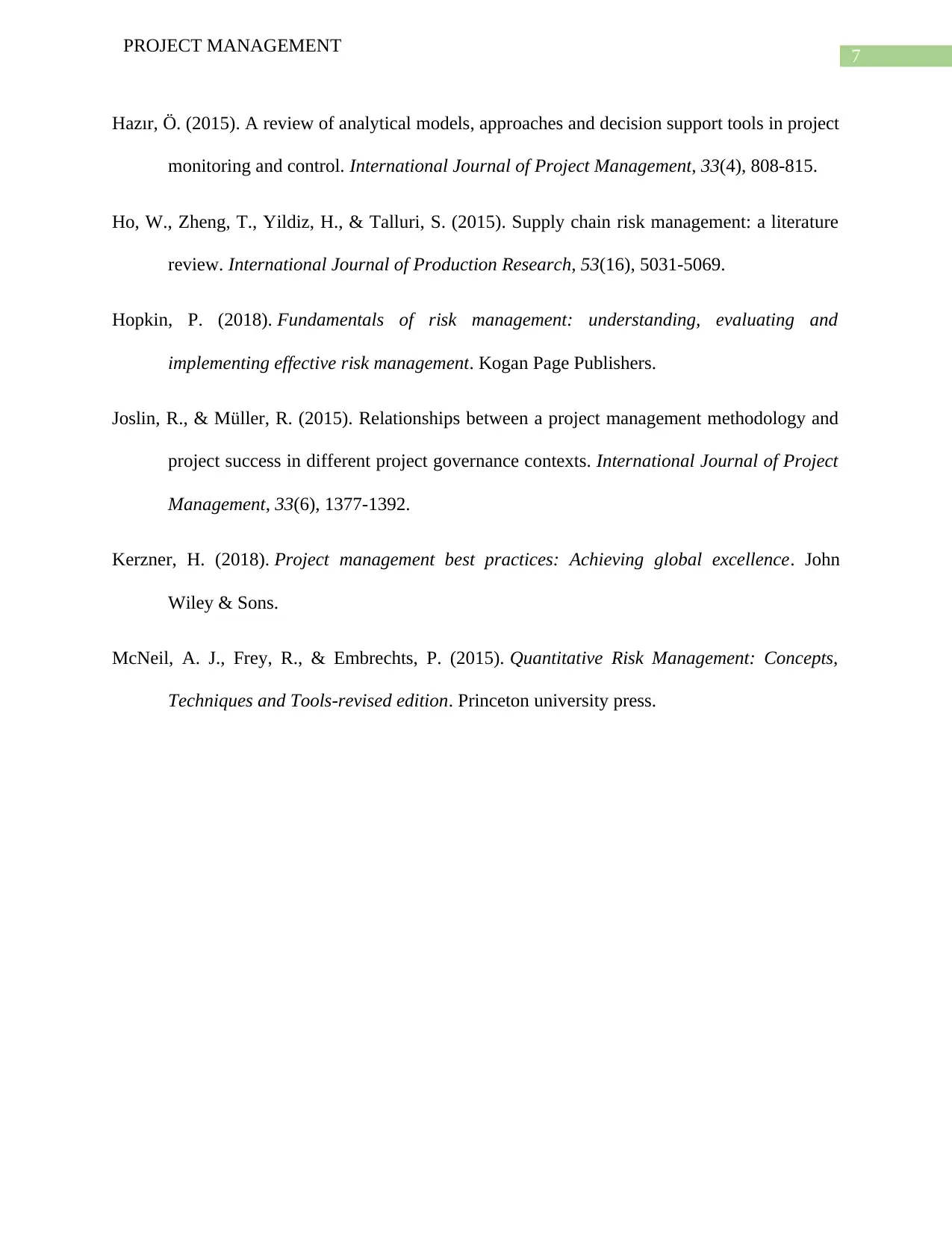
7
PROJECT MANAGEMENT
Hazır, Ö. (2015). A review of analytical models, approaches and decision support tools in project
monitoring and control. International Journal of Project Management, 33(4), 808-815.
Ho, W., Zheng, T., Yildiz, H., & Talluri, S. (2015). Supply chain risk management: a literature
review. International Journal of Production Research, 53(16), 5031-5069.
Hopkin, P. (2018). Fundamentals of risk management: understanding, evaluating and
implementing effective risk management. Kogan Page Publishers.
Joslin, R., & Müller, R. (2015). Relationships between a project management methodology and
project success in different project governance contexts. International Journal of Project
Management, 33(6), 1377-1392.
Kerzner, H. (2018). Project management best practices: Achieving global excellence. John
Wiley & Sons.
McNeil, A. J., Frey, R., & Embrechts, P. (2015). Quantitative Risk Management: Concepts,
Techniques and Tools-revised edition. Princeton university press.
PROJECT MANAGEMENT
Hazır, Ö. (2015). A review of analytical models, approaches and decision support tools in project
monitoring and control. International Journal of Project Management, 33(4), 808-815.
Ho, W., Zheng, T., Yildiz, H., & Talluri, S. (2015). Supply chain risk management: a literature
review. International Journal of Production Research, 53(16), 5031-5069.
Hopkin, P. (2018). Fundamentals of risk management: understanding, evaluating and
implementing effective risk management. Kogan Page Publishers.
Joslin, R., & Müller, R. (2015). Relationships between a project management methodology and
project success in different project governance contexts. International Journal of Project
Management, 33(6), 1377-1392.
Kerzner, H. (2018). Project management best practices: Achieving global excellence. John
Wiley & Sons.
McNeil, A. J., Frey, R., & Embrechts, P. (2015). Quantitative Risk Management: Concepts,
Techniques and Tools-revised edition. Princeton university press.
1 out of 8
Related Documents
Your All-in-One AI-Powered Toolkit for Academic Success.
+13062052269
info@desklib.com
Available 24*7 on WhatsApp / Email
![[object Object]](/_next/static/media/star-bottom.7253800d.svg)
Unlock your academic potential
Copyright © 2020–2025 A2Z Services. All Rights Reserved. Developed and managed by ZUCOL.





